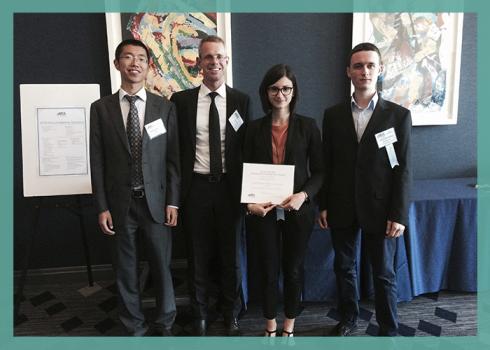You Know, App Building Isn’t Only for Computer Science Majors

Photo of the Strickler Innovation awards winners after the award ceremony. From left to right, pictured are Ruo Jia, Martin Eling, Agnese Mineo and Máté Solymosi.
Need to catch a ride across town? There’s an app for that. Have to send your friend the $10 you owe her for lunch? Just grab your phone. Need to figure out why your car insurance costs what it does? Now there’s an app for that too, thanks to a team of tech-minded risk management students in Switzerland.
Dr. Martin Eling from the University of St. Gallen Institute of Insurance Economics and his team of students recently won the American Risk and Insurance Association’s (ARIA) 2016 Les B. Strickler Innovation in Instruction Award for developing an app they call Optimal Insurance Demand for Students.
Initially conceived of as a study supplement for undergraduate and graduate students taking introductory risk management courses, it became a tool to help all students decide which insurance coverages they need (which we know can be pretty confusing).
And now it’s even more fun to use thanks to a bunch of features like games, case studies and student-produced videos.
The app even has a risk management edition of “Who Wants to Be a Millionaire,” complete with lifelines. The app breaks content down into four main categories: insurable risks, insurance markets, insurance theory and those quizzes and games, plus a growing section on insurance management.
Assembling the team
The app began a few years ago when University of St. Gallen created a working group to encourage innovation in teaching. That’s when Eling came up with the idea to create an insurance app. On the first day of the new semester, Eling laid out the requirements and asked whether any students were interested. Several students volunteered—including one with a lot of tech skills.
“I work in the business school, so we don’t necessarily have a lot of people with backgrounds in computer science,” Eling says. “A big success factor for the project was the fact that we had a student in the first group who could do the detailed programming. We were very lucky.”
Eling said that those six initial students on the project had great chemistry and came up with something really impressive. The next semester, Eling hit upon a strategy to keep pushing for innovative features: each semester, three new students join three students from the previous semester, who remain on the team. That keeps fresh ideas flowing while students with some experience stay involved with the project. This approach has helped push the app beyond the original conception and led to in-depth, interactive features.
The group’s recent Les B. Strickler Innovation in Instruction Award is proof that the formula works. Les B. Strickler was a professor of finance at Oregon State University. In 1990, he created an endowment for ARIA to present an annual award to “encourage creativity and sharing of developments that would improve the quality of risk and insurance education.” The award included $1,000 and a trip to the annual ARIA meeting in Boston so that Eling and his students could present their app and introduce it to a whole new audience.
What’s next for the app
The next question for Eling and his students: What now?
“We got the award from the American Risk and Insurance Association, which we were so happy about,” Eling says. “But we’re at a critical point in the project. We have to figure out what comes next. I believe it’s already a useful tool, but developing it further is a good way to keep it living and current.”
Eling is emphatic that anyone who can get something out of the app should use it freely. Other professors have asked to use the app in their classes, and Eling says that people who saw the ARIA presentation are asking about it as well—but he’s already imaging new uses for the app and coming up with new features. He’s developing a similar platform that can be used in the executive education courses that insurance professionals take through St. Gallen.
Eling has also started pushing his most current research into the app. He’s currently digging into cyber risk and has published an overview of the cyber risks that insurers face and how the issue may develop, along with links to more in-depth research he’s published.
Adding new research on a regular basis is one more way that the app will stay current and relevant for students, executives and other academics. It also bridges a key gap for educators between research and teaching—innovations in instruction have led to a new research platform.
“The university has ‘teaching innovation’ projects,” says Eling. “Many professors are very keen on research, and teaching is maybe the second most important thing to them. It’s good for the institution to push that teaching is as important as research. I very much appreciate that because it’s so important for students.”
As for the specific students involved in the project, Eling has little doubt that they’re headed for bigger and better things in the risk management and insurance industry.
“I was really so happy and also surprised to see how everything developed over time. It was really cool,” Eling says. “It’s like anything—you start with a rough idea, and you just have to find the right people. Developing an app is a cool project and good for future careers. I would be very surprised if the students who were so successful working on the app weren’t also successful in the class and beyond.”
